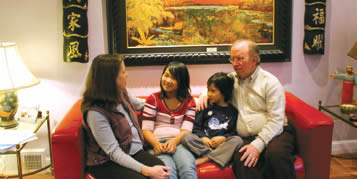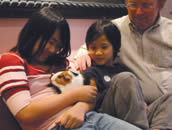By Mary Tablante


Falls Church, VA–Like many couples, Kathleen Brown and John Cullather of Falls Church wanted to start a family and raise children. But when having a biological child wasn’t an option, the couple became interested in international adoption.
Having aged out of adoption for China, they looked at other countries and the possibility of adopting a child from Vietnam. Eleven years ago, they adopted their daughter Claire from the Phu Tho province of Vietnam. Four years later, in 2006, they adopted a son, Peter, from the same province. But others are not as fortunate: Vietnam has been closed to Americans seeking to adopt children since 2008.
In the past year, there’s been substantial focus on Russian adoption, with Russia passing laws barring adoption to Americans. But adoption from Asian countries has continued to become more restrictive, as well. The U.S. State Department does not allow adoptions from Cambodia and Vietnam because of concerns about their adoption practices. Many Americans adopt children from China, but the country has cut back on adoption as well and the waiting period runs six years or more.
International adoptions have been steadily decreasing since 2004, reaching below 18,000. Six out of 10 adopted children had been adopted from an Asian country as recently as 2007.
Vietnam’s adoption issues with the United States are related to allegations of baby-selling and babies being presented for adoption without parents’ consent. And there is a disagreement within the Hague Adoption Convention. The Hague Adoption Convention was created to provide additional protections for international adoptions and member countries are required to work with accredited adoption agencies.
Other requirements under the Hague Adoption Convention include perspective parents must perform 10 hours of training prior to traveling to complete the adoption. There must also be increased communication about adoption fees and medical records. China, India and Thailand are members of the Hague Adoption Convention; South Korea is not.
Allison Martin, who is a webmaster for the support group Families with Children from Vietnam, has two adopted daughters of her own: one from Vietnam and one from Korea. She said she doesn’t feel good about international adoption restrictions that have taken place in recent years.
“They need more transparency in adoption. They need to have rules now, but the rules need to be enforced. And that’s a problem because in the places where people need to get adopted, there is more confusion and less transparency, but there is certainly a lot of people wanting to adopt,” she said.
Cambodian adoption was suspended in 2001 due to controversies with their adoption process. Martin said her 16-year-old daughter would consider adoption in the future, and she would hate for her daughter to not have the opportunity to adopt internationally.
Families like Brown and Cullather’s, as well as Martin’s, decided to have more than one adopted Asian child. For Martin, she said having two adopted children has made a positive difference in how her daughters adapted to being in a Caucasian family.
“It’s really assuring for my older daughter to have another child like her; she felt very close with her,” Martin said. “They would joke being about two Asians in a white family. It just created a special bond for them, and they didn’t feel so different.”
Americans started adopting children internationally after World War II, when most children who were adopted were war orphans from Europe and Japan. Later, adoptions continued after the civil war in Greece, the Korean War and the Vietnam War. Poverty and social upheaval have also played major roles. Many children adopted after the Korea War were biracial, with American fathers from the U.S. military, and Korean mothers. These biracial children were social outcasts and often forced into orphanages.
Kathleen Ja Sook Bergquist, the director of Asian studies at the University of Nevada, specializes in international adoption. Bergquist was an adopted child in the 1960s, when international adoption was less common. Her main expertise is in Korean and Chinese adoption, and she commented on China’s new policies.
“I am not a practitioner, but I know the criteria,” she said. “China has specific criteria around age and weight.” And, she added, “When it came to their attention that gay and lesbian parents were adopting, that became an issue. China has become more restrictive.”
While it is less common for AAPIs to adopt, Bergquist, who is of Korean descent, adopted a child from Korea. One reason Asians adopting Asians may be less common now, Bergquist said, is because blood relations tend to be important in some Asian cultures. But she said this perspective could change with coming generations, who may be more willing to adopt.
For international adoption to continue, Bergquist said those in power must make children and the protection of children their top priorities.
“I’m finding that generation makes a difference in Asian families in larger urban centers because it’s more of a multigenerational community,” she said. “[There is] more likelihood the family [will adopt] if they’re second or third generation.”
She also mentioned that there are certain incentives for Asian American parents who want to adopt from Asia. In China, it is an easier process to adopt a child if the parents are Chinese. In a similar situation, Brown and Cullather had also been looking to India for adoption, but at the time India required at least one parent to be of Indian descent.
Brown hopes that countries open up to American adoption again, for the sake of children and families who want to adopt.
“I’m really sorry that so many international countries have closed down to adoptions because I think there is a real role for international adoptions and it’s a really good thing for children to be moved through institutional settings quickly, so they can find themselves in a family setting,” she said.
 Asian Fortune Your source for all things Asian American
Asian Fortune Your source for all things Asian American



